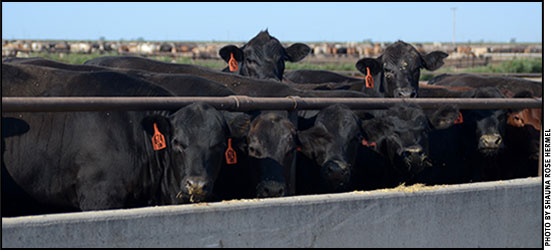
In the Cattle Markets
Retaining ownership in the midst of declining prices.
Under normal market conditions, it can be profitable for cow-calf producers to wean and background their calves in the fall. Historically, feeder-cattle prices dip in early fall when many producers choose to market their calves before bouncing back to higher levels in the late fall and early winter months. Producers who wean and background their calves during this time frame are often able to ride out the seasonal price slump and take advantage of this cycle in normal years.
Is that still the best strategy if the market is in the midst of a price decline that is not expected to fully recover? Some larger producers may be able to use the futures markets to hedge and “lock in” a profitable price with only basis risk, but many smaller producers are not easily afforded this luxury.
So what happens upon closer examination of a few price scenarios? First of all, assume that a producer will want to wean now and will continue to grow the calves for 90 days. In other words, the calves will be weaned now and backgrounded until November. Further, assume that the calves weigh approximately 500 pounds (lb.) today and that they will gain 2 lb. per day. That results in a selling weight of around 680 lb. in November. These are all reasonable assumptions that could apply to many spring-calving cow-calf producers across the United States.
Using the most recent reported Oklahoma City feeder prices, a calf weighing 500 lb. will sell for around $238.41 per hundredweight (cwt.), while a 680-lb. calf will sell for around $214.41 per cwt. That equates to approximately $1,192 for a 500-lb. calf and $1,458 for a 680-lb. animal — a $266.94-per-head difference.
If prices remain constant for the next 90 days and a producer can grow a calf for 90 days for cheaper than $266.94 per head, he/she could turn a profit. However, we all know that prices will likely change between now and November.
Since mid-July, Oklahoma City prices for 650- to 700-lb. steers have dropped by more than $20 per cwt. Friday’s November feeder-cattle futures contract is trading for nearly $7 per cwt. less than the September futures, indicating traders believe cash prices will be lower in November than they are now.
If a producer were to hedge, and assuming that there is no change in basis between now and November, the difference in revenue between selling now and backgrounding until November narrows from $266.94 per head to $215.55 per head. While some producers could hedge and ensure themselves a gross return of $215.55, one would need at least 73 steers to be able to hedge without assuming at least some additional risk through speculation.
If 650- to 700-lb. steer prices drop even more to $200 per cwt. or even $195 per cwt., the difference narrows to roughly $168 per head and $134 per head, respectively. As the revenue differences shrink, it becomes much more difficult to cover costs, and the door starts to open for potential losses instead of profits.
There is a great deal of uncertainty surrounding today’s cattle markets. The bears have been running the show recently, and it looks like the trend might continue into the near future. The possibility always exists that markets could turn the other way as well, particularly given such tight supplies. It is more important now than ever before that U.S. cattle producers are aware of market movements and how price fluctuations can impact their bottom lines, especially those who plan on retaining their calves past weaning.

Editor’s Note: Brian Williams is assistant extension professor in the Department of Agricultural Economics at Mississippi State University. Reprinted with permission, this article was originally written for the Livestock Marketing Information Center, available online at http://lmic.org.





